resources
What Is HR Analytics and How Can It Help HR Management?
July 07, 2023
HR analytics use employee and workforce data to identify causal relationships and predict future trends. Learn everything you need to know right here.
Blog Post

Managing human resources sometimes feels like juggling — on a rollercoaster.
In an ideal world, every branch of HR would align with your business goals and boost performance, but companies across the globe are lagging behind in people and workforce management.
If you’re among them, your business is likely generating loads of data from across several HR disciplines — but doing anything with that information is another story altogether.
What if you could successfully leverage this information to implement company-wide improvements? Learning about HR analytics, why it's essential, and how to leverage it for actionable insight can revolutionize how you use data to better manage your business.
What Is HR Analytics?
HR analytics collects employee and workforce datasets from various business systems and organizes it in one space to identify causal relationships and predict future trends. Typical datasets deal with job performance, recruitment, training, employee engagement, and other HR metrics.
Coupled with the right statistical skills and analytics tools, HR teams and C-suite executives can use these datasets to make better-informed decisions that align with business goals.
HR analytics is broad and comprehensive, so it helps to break them down into categories based on use case.
Types of HR Analytics
There are two main categories that come under the umbrella of human resource analytics.
- People analytics - Also called talent analytics, this field is mainly concerned with your employees' performance, engagement, and job satisfaction. Its purpose is to understand the talent in your organization.
- Workforce analytics - This is where the ever-popular HR metrics like employee turnover and retention rear their heads. Workforce analytics drives strategic workforce planning for areas like scheduling, training and development, recruitment, and other tasks that support your business’s ability to meet future demand.
Three Analytical Methods
As it’s said, good things come in threes, and HR Analytics is no different:
1. Descriptive analytics
Analyzing datasets to “describe” or explain why something happened. This is the simplest form of analysis and can illuminate areas that need improvement. For example, historical data can show how much revenue is lost due to employee absenteeism.
2. Predictive analytics
Constructing statistical models that make forecasts based on past data. Predictive analytics need constant streams of real-time data for the models to remain precise. An example of this method would be reviewing data from the prior year to predict how many fully trained salespeople are needed for the upcoming quarter or season.
3. Prescriptive analytics
Another step up from making projections is making recommendations for how to achieve business goals. This is accomplished using complicated mathematical algorithms and machine learning technologies. Data is constantly fed into predictive models that then attempt various solutions with forecasted consequences.
For example, this method would do more than just identify an organization’s talent gap and predict its down-trending future. Prescriptive analytics goes further to recommend a course of action to remedy that gap, such as raising your recruitment budget or increasing starting salaries for certain positions.
How HR Data Analytics Impacts Business Results
While insightful, all of the data and analysis in the world are ultimately useless if they don’t create positive results for the organization or success stories for others to learn from.
Better Decision-making
In HR, we’re always creating and documenting data, but in less discerning organizations it often remains in the dark and unused.
But you know better. You know there are relationships to be worked out and dots to connect that can make a real impact. With an HR analytics and reporting system, it’s possible to better prepare your company for what lies ahead.
For example, HR analytics might nudge you to create engagement and learning programs targeting tenured employees — boosting or maintaining current production for years to come.
Increased Optimization
HR analytics can also direct how to optimize your workforce. Data from areas like recruitment, training, compensation, and others can be analyzed to evaluate efficiencies of individuals, teams, or the entire company.
Reporting tools can then help you visualize your processes to spot gaps that’re affecting workforce planning and employee performance. You may end up discovering that you need to invest more in employee education or cut back on recruiting efforts.
These types of insights can have a material impact on your bottom line.
For example, a credit union used HR data to determine it wasn’t profitable to keep their branches open on Saturdays. This insight prompted the company to switch to a five-day work week, leading to annual savings of $210,000 a year.
Examples of HR Analytics Metrics
HR analytics can set you on the right track — so long as you’re armed with the correct metrics. Here are a few you’ll want to monitor:
Employee Turnover and Retention Rates
When employees leave, morale is lowered, and other team members have to pick up the slack.
Fortunately, employee turnover and retention rates are relatively easy to track. A workforce management solution can streamline the data collection process and predict turnover/retention rates so you can plan accordingly.
Cost Per Hire
Recruiting and onboarding new hires is costly, accounting for up to one-third of a worker’s annual salary. You’ll spend a lot of time and money bringing in, training, and retaining top talent, so you want to accurately quantify the cost per hire for every position in your company.
Cost per hire paints a clear picture of the ROI for your recruiting and onboarding efforts. Tracking this metric can thus inform workforce planning strategies and help you optimize for value.
Time to Hire
As part of workforce planning, you need to know the average lead time attached to filling a vacant role. Two HR metrics, in particular, will give you a better understanding of your recruitment process.
- Time to Fill - This is the time required for the entire hiring process, from creating the job opening to a candidate accepting the role.
- Time to Hire - This measures the time it takes from talent entering your recruiting pipeline until they accept the job offer.
The former accounts for the total lead time, while the latter tracks the efficiency of your hiring process.
Pay Equity
We know that compensation is about as sensitive a topic as it gets. Many times, when a team member approaches you with a pay issue, your hands are tied. Your HR team can alleviate this problem with better pay transparency (this might also help you to comply with local regulations).
As a payroll metric, pay equity keeps a watchful eye out for pay discrepancies that may or may not be due to gender, race, age, or other reasons.
Diversity, Equity, Inclusion, and Accessibility (DEIA)
You need to track employee demographics if you want your organization to be truly about people. By leading the way as a progressive company, you can create a unique business culture that attracts and retains top performers.
Deloitte found that 86% of employees who believe their company has a distinct, clearly articulated culture also report feeling valued by their employer.
Employee Performance
Employee performance can be measured using both quantitative and qualitative data. You’ll likely need access to information like sales, revenue, appraisal reports, disciplinary notes, and other sources to evaluate it accurately.
Measuring employee performance with any degree of accuracy requires performance management that allows for continuous metric tracking. This will enable predictive analytics to proactively catch disengaging employees or those struggling to adopt new processes.
Read More: 10 HR Metrics That Matter to Your C-Suite
Analyze Data Seamlessly with HR Analytics Tools
HR professionals have a lot on their plates, but we also have access to plenty of big data. The question is, where do you start?
The answer can be found in a modern human resource information system (HRIS). Analytics tools can help lighten the load by implementing artificial intelligence (AI) in HR tasks so you can accelerate the growth of your business.
Paylocity’s all-in-one HR and Payroll software contains a full suite of tools, including HR reporting software. Our Data Insights platform makes it easy to track and measure metrics like DEIA, labor costs, and retention. All data feeds back to our Modern Workforce Index (MWI) dashboard to help decision-makers visualize analysis and plan for the future.
With a comprehensive solution like Paylocity, you’re getting more than a digital tool — you’re entering into a partnership. Moving forward together, our platform streamlines tedious administrative tasks, so you have more time for the important stuff.
Request a demo today to learn how Paylocity can help your organization leverage the power of data.

Make Data Work for You
Are you still relying on instincts or assumptions to help you make decisions? Your workforce is changing fast. It’s time for a better approach. With a real-time, easy-to-understand analytics dashboard, you can see what’s really going on in your company and make smart moves based on data. Share insights and results quickly with tailored reporting, and get to know your employees better to improve your overall experience.


